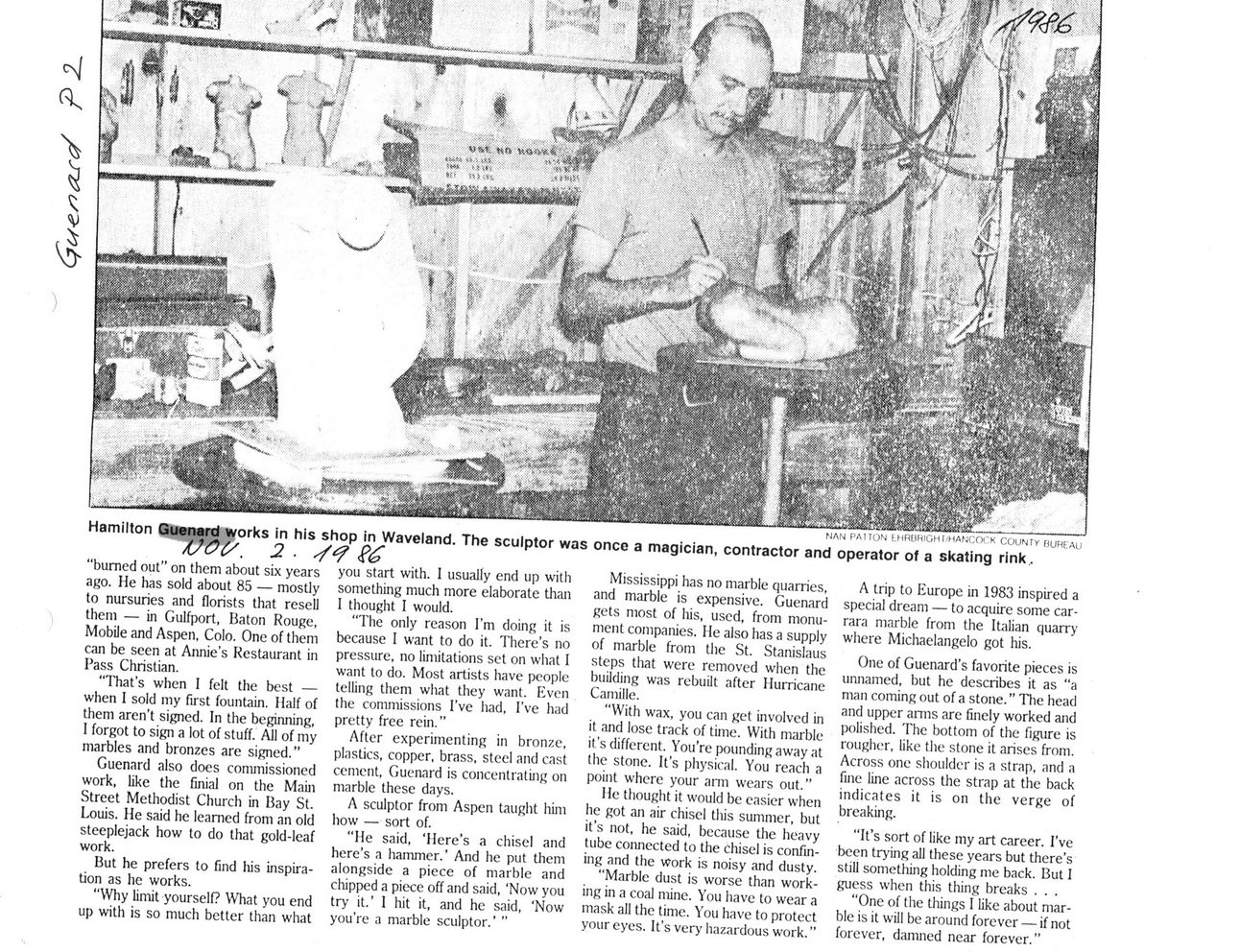This text was obtained via automated optical character recognition.
It has not been edited and may therefore contain several errors.
NAN PATTON tMRORIGHJ.'HANCOl K COUNTY BURtAU Hamilton Gurnard works in his shop in Waveland. The sculptor was once a magician, contractor and operator of a skating rink. VO O'. 2 . ?burned out? on them about six years ago. He has sold about 85 ? mostly to nursuries and florists that resell them ? in Gulfport, Baton Rouge, Mobile and Aspen, Colo. One of them can be seen at Annie?s Restaurant in Pass Christian. ?That?s when I felt the best ? when I sold my first fountain. Half of them aren't signed. In the beginning, I forgot to sign a lot of stuff. All of my marbles and bronzes are signed.? Guenard also does commissioned work, like the finial on the Main Street Methodist Church in Bay St. Louis. He said he learned from an old steeplejack how to do that gold-leaf work. But he prefers to find his inspiration as he works. "Why limit yourself? What you end up with is so much better than what you start with. I usually end up with something much more elaborate than I thought 1 would. "The only reason I?m doing it is because I want to do it. There?s no pressure, no limitations set on what I want to do. Most artists have people telling them what they want. liven the commissions I?ve had, I?ve had pretty free rein.? After experimenting in bronze, plastics, copper, brass, steel and cast cement, Guenard is concentrating on marble these days. A sculptor from Aspen taught him how ? sort of. "He said, ?Here?s a chisel and here?s a hammer.? And he put them alongside a piece of marble and chipped a piece off and said, ?Now you try it.? 1 hit it, and he said, 'Now you're a marble sculptor.? ? Mississippi has no marble quarries, and marble is expensive. Guenard gets most of his, used, from monument companies. I le also has a supply of marble from the St. Stanislaus steps that were removed when the building was rebuilt after Hurricane Camille. ?With wax, you can get involved in it and lose track of time. With marble it?s different. You?re pounding away at the stone. It?s physical. You reach a point where your arm wears out.? He thought it would be easier when he got an air chisel this summer, but it?s not, he said, because the heavy tube connected to the chisel is confining and the work is noisy and dusty. "Marble dust is worse than working in a coal mine. You have to wear a mask all the time. You have to protect your eyes. It's very' hazardous work.? A trip to Europe in 1983 inspired a special dream ? to acquire some Carrara marble from the Italian quarry where Michaelangelo got his. One of Guenard?s favorite pieces is unnamed, but he describes it as ?a man coming out of a stone.? The head and upper amis are finely worked and polished. The bottom of the figure is rougher, like the stone it arises from. Across one shoulder is a strap, and a fine line across the strap at the back indicates it is on the verge of breaking. "It?s sort of like my art career. I've been trying all these years but there?s still something holding me back. But I guess when this thing breaks . . . ?One of the things 1 like about marble is it will be around forever ? if not forever, damned near forever.?

Artists Local 23